| Artemisia Gentileschi
The Art History Archive - Biography & Art
Biography of Artemisia Gentileschi: (Born July 8th 1593, Died 1653) Artemisia Gentileschi was the most important woman painter of Early Modern Europe by virtue of the excellence of her work, the originality of her treatment of traditional subjects, and the number of her paintings that have survived (though only thirty-four of a much larger corpus remain, many of them only recently attributed to her rather than to her male contemporaries). She was both praised and disdained by contemporary critical opinion, recognized as having genius, yet seen as monstrous because she was a woman exercising a creative talent thought to be exclusively male. Since then, in the words of Mary D. Garrard, she "has suffered a scholarly neglect that is almost unthinkable for an artist of her caliber." Artemisia Gentileschi was born on July 8, 1593 to Orazio Gentileschi, painter and to Prudentia Montone, who died when Artemisia was young. She was their only daughter. Her father trained her from an early age as an artist, and introduced her to the numerous artists of Rome, including Caravaggio whose use of dramatic chiaroscuro (light and shadow) influenced her painting. Like many other women artists of her era who were excluded from apprenticeship in the studios of successful artists, Gentileschi was the daughter of a painter. She was born in Rome on July 8, 1593, the daughter of Orazio and Prudentia Monotone Gentileschi. Her mother died when Artemisia was twelve. Her father trained her as an artist and introduced her to the working artists of Rome, including Michelangelo Merisi da Caravaggio, whose chiaroscuro style (contrast of light and shadow) greatly influenced Artemisia Gentileschi's work. Other than artistic training, she had little or no schooling; she did not learn to read and write until she was adult. However, by the time she was seventeen, she had produced one of the works for which she is best known, her stunning interpretation of Susanna and the Elders (1610).
Among those with whom Orazio Gentileschi worked was the Florentine artist Agostino Tassi, whom Artemisia accused of raping her in 1612, when she was nineteen. Her father filed suit against Tassi for injury and damage, and, remarkably, the transcripts of the seven-month-long rape trial have survived. According to Artemisia, Tassi, with the help of family friends, attempted to be alone with her repeatedly, and raped her when he finally succeeded in cornering her in her bedroom. He tried to placate her afterwards by promising to marry her, and gained access to her bedroom (and her person) repeatedly on the strength of that promise, but always avoided following through with the actual marriage. The trial followed a pattern familiar even today: she was accused of not having been a virgin at the time of the rape and of having many lovers, and she was examined by midwives to determine whether she had been "deflowered" recently or a long time ago. Perhaps more galling for an artist like Gentileschi, Tassi testified that her skills were so pitiful that he had to teach her the rules of perspective, and was doing so the day she claimed he raped her. Tassi denied ever having had sexual relations with Gentileschi and brought many witnesses to testify that she was "an insatiable whore." Their testimony was refuted by Orazio (who brought countersuit for perjury), and Artemisia's accusations against Tassi were corroborated by a former friend of his who recounted Tassi's boasting about his sexual exploits at Artemisia's expense. Tassi had been imprisoned earlier for incest with his sister-in-law and was charged with arranging the murder of his wife. He was ultimately convicted on the charge of raping Gentileschi; he served under a year in prison and was later invited again into the Gentileschi household by Orazio.
During and soon after the trial, Gentileschi painted Judith Slaying Holofernes (1612-1613). The painting is remarkable not only for its technical proficiency, but for the original way in which Gentileschi portrays Judith, who had long been a popular subject for art. One month after the long trial ended, in November of 1612, Artemisia was married to a Florentine artist, Pietro Antonio di Vincenzo Stiattesi, and they moved to Florence, probably the next year. While there, she had a daughter named either Prudentia or Palmira. In Florence, Gentileschi returned to the subject of Judith, completing Judith and her Maidservant in 1613 or 1614. Again, Gentileschi's treatment of the familiar subject matter is unexpected and original.
Both she and her husband worked at the Academy of Design, and Gentileschi became an official member there in 1616--a remarkable honor for a woman of her day probably made possible by the support of her Florentine patron, the Grand Duke Cosimo II of the powerful Medici family. During her years in Florence, he commissioned quite a few paintings from her, and Gentileschi left Florence to return to Rome upon his death in 1621. From there she probably moved to Genoa that same year, accompanying her father who was invited there by a Genovese nobleman. While there she painted her first Lucretia (1621) and her first Cleopatra (1621-1622). She also received commissions in nearby Venice during this period and met Anthony Van Dyck, a very successful painter of the era, and also perhaps Sofonisba Anguissola, a generation older than Gentileschi and one of the handful of women who worked as artists. Gentileschi soon returned to Rome and is recorded as living there as head of household with her daughter and two servants. Evidently she and her husband had separated and she eventually lost touch with him altogether. Gentileschi later had another daughter, and both are known to have been painters, though neither their work nor any assessment of it has survived. During this stay in Rome, a French artist, Pierre Dumonstier le Neveu, made a drawing of her hand holding a paintbrush, calling it a drawing of the hand of "the excellent and wise noble woman of Rome, Artemisia." Her fame is also evident in a commemorative medal bearing her portrait made some time between 1625 and 1630 that calls her pictrix celebris or "celebrated woman painter." Also at this time, Jerome David painted her portrait with the inscription calling her "the famous Roman painter."
Artemisia did well in Florence, gaining the support and patronage of Grand Duke Cosimo Medici. When he died in 1621, she painted with her father in Genoa, where she completed her Lucretia and Cleopatra. Forever in search of patronage, she lived again in Florence and Rome during the 1620s, then moved in 1630, to Naples, the second largest city in Europe, where commissions were available. During this time, she was continually struggling to reconcile her own artistic preferences with the preferences of her patrons, who made her livelihood possible. Here in Naples, she painted her Bathsheba, and Lot and His Daughters, and raised the money she sought for her own daughter's marriage in 1637. Some time between 1626 and 1630 Gentileschi moved to Naples, where she remained until 1638. She is again listed as "head of household." While there, she painted her Self-Portrait as the Allegory of Painting (1630), a work unique in its fusing of art, muse, and artist, The Annunciation (1630), another Lucretia, another Cleopatra, and many other works. She collaborated with a number of (male) artists while in Naples. In 1637, desperate for money to finance her daughter's wedding, Gentileschi began looking for new patrons. In one letter soliciting commissions, she mentions "a youthful work done by [her] daughter" that she is sending along.
|
|
|
The new patron to whom she finally attached herself was King Charles I of England. Gentileschi was in residence at the English court from 1638 to 1641, one of many continental artists invited there by that art-collecting king. She may have gone specifically to assist her father, Orazio, in a massive project to decorate the ceilings of the Queen's house at Greenwich. After civil war had broken out in England in 1641 (a war that would result in the death of Charles I), Artemisia returned to Naples where she lived until her death. She remained very active there, painting at least five variations on Bathsheba and perhaps another Judith. The only record of her death is in two satiric epitaphs--frequently translated and reprinted--that make no mention of her art but figure her in exclusively sexual terms as a nymphomaniac and adulterer.
There has recently been a movie made about Gentileschi called Artemisia, which has been widely criticized for its biographical and historical inaccuracy. Although separated from her father for many years, Artemisia joined him in 1638 on a joint painting commission for King Charles I of England, painting ceiling canvases for the Queen's house. Here, Artemisia painted the Allegory of Peace, including most of its Muses - and most notably, Clio, Muse of History. Her ailing father died in 1639, but Artemisia continued to work in England until 1642, when she returned to Naples. During her last ten years, her primary patron was Don Antonio Ruffo; more is known about these years than any others because 28 of her letters to him which still survive. The cause and timing of Artemisia's death is not known, but she most likely died in 1652. Unfortunately, however, the rape trial, her unconventional life as a female painter, and her numerous paintings of powerful women struggling against male dominance did not endear her to the male aristocracy. Several derogatory epitaphs were published about her in 1653, such as: "By painting one likeness after another/ I earned no end of merit in the world/ While, to carve two horns upon my husband's head/I put down the brush and took a chisel instead." Art historian Charles Moffat believes Artemisia may have committed suicide, which would explain why the cause of her death was not recorded.
| |
Click Here to Join some Webrings
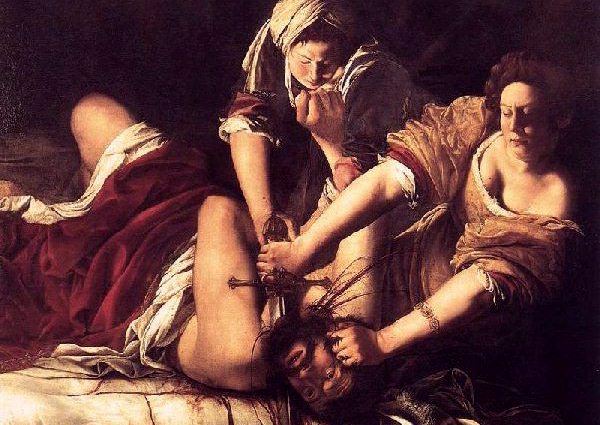
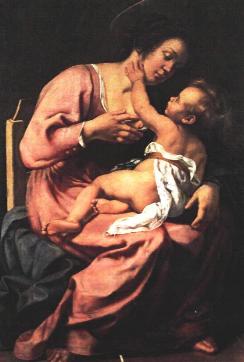 Orazio painted frescos with the artist, Agostino Tassi, whom he asked to teach her daughter perspective. During these lessons, Tassi raped the 18 year old Artemisia, and promising to soon marry her, continued to demand her sexual favors. When her father found out, Tassi was arrested for rape, and Artemisia was thrust into the middle of a celebrated rape case which received considerable publicity and ruined her reputation. Tassi was convicted, but released by the judge, who also ordered Artemisia to be tortured as a means of proving her honesty. The transcripts of the trial are still available today.
Orazio painted frescos with the artist, Agostino Tassi, whom he asked to teach her daughter perspective. During these lessons, Tassi raped the 18 year old Artemisia, and promising to soon marry her, continued to demand her sexual favors. When her father found out, Tassi was arrested for rape, and Artemisia was thrust into the middle of a celebrated rape case which received considerable publicity and ruined her reputation. Tassi was convicted, but released by the judge, who also ordered Artemisia to be tortured as a means of proving her honesty. The transcripts of the trial are still available today.
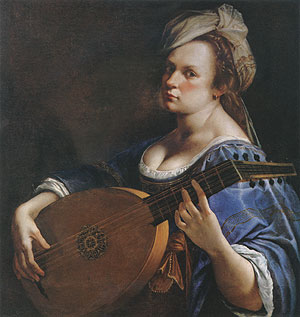 Paintings by Artemisia Gentileschi:
Paintings by Artemisia Gentileschi:
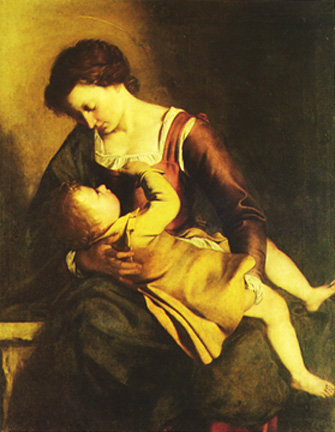 The pregnant Artemisia was married off one month after the trial to a family friend, Peter Antonio Stiattesi whom she left within a few years. Soon after the trial, she painted her first Judith beheading Holofernes painting, clearly a cathartic expression of her rage and violation.
The pregnant Artemisia was married off one month after the trial to a family friend, Peter Antonio Stiattesi whom she left within a few years. Soon after the trial, she painted her first Judith beheading Holofernes painting, clearly a cathartic expression of her rage and violation.
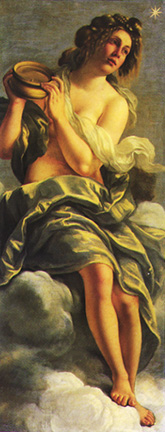 During the years after the trial, Artemisia lived in Florence, where she gave birth to a daughter, and became the protege of Michelangelo the Younger, nephew of Michelangelo, who favored her and paid her well for her work on the life of Michelangelo for the Casa Buonoratti. Here, she painted the panel/frieze "Inclinazione", pictured on the left.
During the years after the trial, Artemisia lived in Florence, where she gave birth to a daughter, and became the protege of Michelangelo the Younger, nephew of Michelangelo, who favored her and paid her well for her work on the life of Michelangelo for the Casa Buonoratti. Here, she painted the panel/frieze "Inclinazione", pictured on the left.
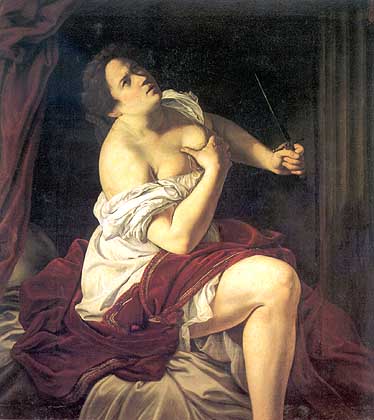 Thirty four of her paintings survive today, as well as the near complete transcript of the rape trial, published in full in Mary Gerrard's Artemisia Gentileschi, The Image of the Female Hero in Italian Baroque Art.
Thirty four of her paintings survive today, as well as the near complete transcript of the rape trial, published in full in Mary Gerrard's Artemisia Gentileschi, The Image of the Female Hero in Italian Baroque Art.